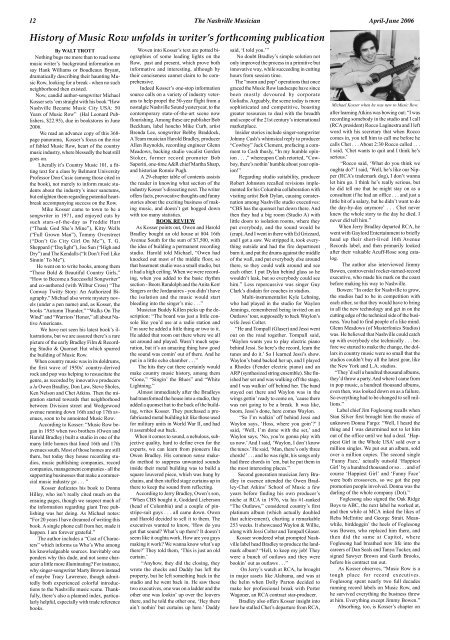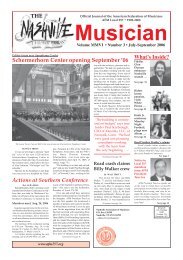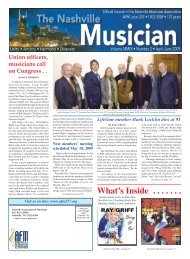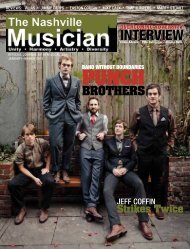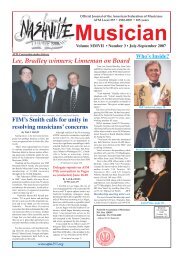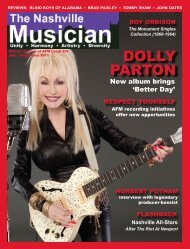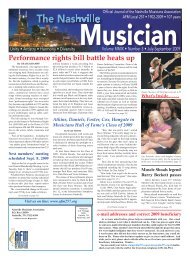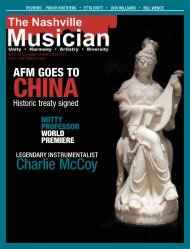Volume MMVI • Number 2 • April-June 2006 - Nashville Musicians ...
Volume MMVI • Number 2 • April-June 2006 - Nashville Musicians ...
Volume MMVI • Number 2 • April-June 2006 - Nashville Musicians ...
You also want an ePaper? Increase the reach of your titles
YUMPU automatically turns print PDFs into web optimized ePapers that Google loves.
12 The <strong>Nashville</strong> Musician <strong>April</strong>-<strong>June</strong> <strong>2006</strong><br />
History of Music Row unfolds in writer’s forthcoming publication<br />
By WALT TROTT<br />
Nothing bugs me more than to read some<br />
music writer’s background information on<br />
say Hank Williams or Boudleaux Bryant,<br />
dramatically describing their haunting Music<br />
Row, looking for a break - when no such<br />
neighborhood then existed.<br />
Now, candid author-songwriter Michael<br />
Kosser sets ’em straight with his book “How<br />
<strong>Nashville</strong> Became Music City USA: 50<br />
Years of Music Row” (Hal Leonard Publishers,<br />
$22.95), due in bookstores in <strong>June</strong><br />
<strong>2006</strong>.<br />
We read an advance copy of this 368page<br />
panorama, Kosser’s focus on the rise<br />
of fabled Music Row, heart of the country<br />
music industry, where blessedly the beat still<br />
goes on.<br />
Literally it’s Country Music 101, a fitting<br />
text for a class by Belmont University<br />
Professor Don Cusic (among those cited in<br />
the book), not merely to inform music students<br />
about the industry’s inner sanctums,<br />
but enlighten them regarding potential heartbreak<br />
accompanying success on the Row.<br />
Mike Kosser came to town to be a<br />
songwriter in 1971, and enjoyed cuts by<br />
such stars-of-the-day as Freddie Hart<br />
(“Thank God She’s Mine”), Kitty Wells<br />
(“Full Grown Man”), Tommy Overstreet<br />
(“Don’t Go City Girl On Me”), T. G.<br />
Sheppard (“Daylight”), Joe Sun (“High and<br />
Dry”) and The Kendalls (“It Don’t Feel Like<br />
Sinnin’ To Me”).<br />
He went on to write books, among them<br />
“Those Bold & Beautiful Country Girls,”<br />
“How to Become a Successful Songwriter”<br />
and co-authored (with Wilbur Cross) “The<br />
Conway Twitty Story: An Authorized Biography.”<br />
Michael also wrote mystery novels<br />
(under a pen name) and, as Kosser, the<br />
books “Autumn Thunder,” “Walks On The<br />
Wind” and “Warriors’ Honor,” all about Native<br />
Americans.<br />
We have not seen his latest book’s illustrations,<br />
but we are assured there’s a rare<br />
picture of the early Bradley Film & Recording<br />
Studio & Quonset Hut which spurred<br />
the building of Music Row.<br />
When country music was in its doldrums,<br />
the first wave of 1950s’ country-derived<br />
rock and pop was helping to resuscitate the<br />
genre, as recorded by innovative producers<br />
a la Owen Bradley, Don Law, Steve Sholes,<br />
Ken Nelson and Chet Atkins. Then the migration<br />
started towards that neighborhood<br />
between Division street and Wedgewood<br />
avenue running down 16th and up 17th avenues,<br />
soon to be annointed Music Row.<br />
According to Kosser: “Music Row began<br />
in 1955 when two brothers (Owen and<br />
Harold Bradley) built a studio in one of the<br />
many little homes that lined 16th and 17th<br />
avenues south. Most of those homes are still<br />
there, but today they house recording studios,<br />
music publishing companies, record<br />
companies, management companies - all the<br />
supporting businesses that make a commercial<br />
music industry go . . . ”<br />
Kosser dedicates his book to Donna<br />
Hilley, who isn’t really cited much on the<br />
ensuing pages, though we suspect much of<br />
the information regarding giant Tree publishing<br />
was her doing. As Michael notes:<br />
“For 20 years I have dreamed of writing this<br />
book. A single phone call from her, made it<br />
happen. I am forever grateful.”<br />
The author includes a “Cast of Characters”<br />
which informs us Who’s Who among<br />
his knowledgeable sources. Inevitably one<br />
ponders why this dude, and not some character<br />
a little more illuminating? For instance,<br />
why singer-songwriter Marty Brown instead<br />
of maybe Tracy Lawrence, though admittedly<br />
both experienced colorful introductions<br />
to the <strong>Nashville</strong> music scene. Thankfully,<br />
there’s also a planned index, particularly<br />
helpful, especially with trade reference<br />
books.<br />
Woven into Kosser’s text are potted biographies<br />
of some leading lights on the<br />
Row, past and present, which prove both<br />
informative and interesting, although by<br />
their conciseness cannot claim to be comprehensive.<br />
Indeed Kosser’s one-stop information<br />
source calls on a variety of industry veterans<br />
to help propel the 50-year flight from a<br />
nostalgic <strong>Nashville</strong> Sound yesteryear, to the<br />
contemporary state-of-the-art scene now<br />
flourishing. Among these are publisher Bob<br />
Beckham, label honcho Mike Curb, artist<br />
Brenda Lee, songwriter Bobby Braddock,<br />
A Team musician Harold Bradley, producer<br />
Allen Reynolds, recording engineer Glenn<br />
Meadows, backing studio vocalist Gordon<br />
Stoker, former record promoter Bob<br />
Saporiti, one-time A&R chief Martha Sharp,<br />
and historian Ronnie Pugh.<br />
A 29-chapter table of contents assists<br />
the reader in knowing what section of the<br />
industry Kosser’s dissecting next. The writer<br />
offers facts, provocative thoughts and funny<br />
stories about the exciting business of making<br />
music, and doesn’t get bogged down<br />
with too many statistics.<br />
BOOK REVIEW<br />
As Kosser points out, Owen and Harold<br />
Bradley bought an old house at 804 16th<br />
Avenue South for the sum of $7,500, with<br />
the idea of building a permanent recording<br />
studio. Harold told Michael, “Owen had<br />
knocked out most of the middle floor, so<br />
that basement studio was a small studio, but<br />
it had a high ceiling. When we were recording,<br />
when you added to the basic rhythm<br />
section - Boots Randolph and the Anita Kerr<br />
Singers or the Jordanaires - you didn’t have<br />
the isolation and the music would start<br />
bleeding into the singer’s mic . . .”<br />
Musician Buddy Killen picks up the description:<br />
“The board was just a little console<br />
like you’d use at a radio station and<br />
I’m sure he added a little thing or two to it.<br />
He added that room out there where we all<br />
sat around and played. Wasn’t much separation,<br />
but it’s an amazing thing how good<br />
the sound was comin’ out of there. And he<br />
put in a little echo chamber . . .”<br />
The hits they cut there certainly would<br />
make country music history, among them<br />
“Gone,” “Singin’ the Blues” and “White<br />
Lightning.”<br />
Almost immediately after the Bradleys<br />
had transformed the house into a studio, they<br />
added a quonset hut to the back of the building,<br />
writes Kosser. They purchased a prefabricated<br />
metal building kit like those used<br />
for military units in World War II, and had<br />
it assembled out back.<br />
When it comes to sound, a nebulous, subjective<br />
quality, hard to define even for the<br />
experts, we can learn from pioneers like<br />
Owen Bradley. His common sense makedo<br />
method to suppress unwanted sounds<br />
inside their metal building was to build a<br />
square louvered piece, which was hung by<br />
chains, and then stuffed stage curtains up in<br />
there to keep the sound from reflecting.<br />
According to Jerry Bradley, Owen’s son,<br />
“When CBS bought it, Goddard Lieberson<br />
(head of Columbia) and a couple of pinstripe-suit<br />
guys . . . all came down. Owen<br />
and Harold decided to sell it to them. The<br />
executives wanted to know, ‘How do you<br />
get that sound? What’s up there? It doesn’t<br />
seem like it oughta work. How are you guys<br />
making it work? We wanna know what’s up<br />
there?’ They told them, ‘This is just an old<br />
curtain.’<br />
“Anyhow, they did the closing, they<br />
wrote the checks and Daddy has left the<br />
property, but he left something back in the<br />
studio and he went back in. He saw these<br />
two executives, one was on a ladder and the<br />
other one was lookin’ up over the louvers<br />
there, and he told the other one, ‘Hey there<br />
ain’t nothin’ but curtains up here.’ Daddy<br />
said, ‘I told you.’”<br />
No doubt Bradley’s simple solution not<br />
only improved the process in a primitive but<br />
innovative way, while succeeding in cutting<br />
hours from session time.<br />
The “mom and pop” operations that once<br />
graced the Music Row landscape have since<br />
been mostly devoured by corporate<br />
Goliaths. Arguably, the scene today is more<br />
sophisticated and competitive, boasting<br />
greater resources to deal with the breadth<br />
and scope of the 21st century’s international<br />
marketplace.<br />
Insider stories include singer-songwriter<br />
Johnny Cash’s whimsical reply to producer<br />
“Cowboy” Jack Clement, prefacing a comment<br />
to Cash thusly, “In my humble opinion<br />
. . . ,” whereupon Cash retorted, “Cowboy,<br />
there’s nothin’ humble about your opinion!”<br />
Regarding studio suitability, producer<br />
Robert Johnston recalled revisions implemented<br />
for his Columbia collaboration with<br />
visiting artist Bob Dylan, causing consternation<br />
among <strong>Nashville</strong> studio executives:<br />
“CBS has the quonset hut down there. And<br />
then they had a big room (Studio A) with<br />
little doors to isolation rooms, where they<br />
put everybody, and the sound would be<br />
(crap). And I went in there with Ed Grizzard,<br />
and I got a saw. We stripped it, took everything<br />
outside and had the fire department<br />
burn it, and put the drums against the middle<br />
of the wall, and put everybody else around<br />
there, so they could walk around and see<br />
each other. I put Dylan behind glass so he<br />
wouldn’t leak, but so everybody could see<br />
him.” Less repercussive was singer Guy<br />
Clark’s disdain for couches in studios.<br />
Multi-instrumentalist Kyle Lehning,<br />
who had played in the studio for Waylon<br />
Jennings, remembered being invited on an<br />
Outlaws’ tour, supposedly to back Waylon’s<br />
wife Jessi Colter.<br />
“He and Tompall (Glaser) and Jessi went<br />
out on the road together. Tompall said,<br />
‘Waylon wants you to play electric piano<br />
behind Jessi. So here’s the record, learn the<br />
tunes and do it.’ So I learned Jessi’s show.<br />
Waylon’s band backed her up, and I played<br />
a Rhodes (Fender electric piano) and an<br />
ARP (synthesized string ensemble). She finished<br />
her set and was walking off the stage,<br />
and I was walkin’ off behind her. The band<br />
stayed out there and Waylon was in the<br />
wings gettin’ ready to come on, ’cause there<br />
was not going to be a break. It was like,<br />
boom, Jessi’s done, here comes Waylon.<br />
“So I’m walkin’ off behind Jessi and<br />
Waylon says, ‘Hoss, where you goin’?’ I<br />
said, ‘Well, I’m done with the set,’ and<br />
Waylon says, ‘No, you’re gonna play with<br />
us now.’ And I said, ‘Waylon, I don’t know<br />
the tunes.’ He said, ‘Man, there’s only three<br />
chords!’ . . . and he was right, his songs only<br />
had three chords in ’em, but he put them in<br />
the most interesting places.”<br />
Second generation musician Jerry Bradley<br />
in essence attended the Owen Bradley-Chet<br />
Atkins’ School of Music a few<br />
years before finding his own producer’s<br />
niche at RCA in 1976, via his #1-ranked<br />
“The Outlaws,” considered country’s first<br />
platinum album (which actually doubled<br />
that achievement), charting a remarkable<br />
253 weeks. It showcased Waylon & Willie,<br />
along with Jessi Colter and Tompall Glaser.<br />
Kosser wondered what prompted <strong>Nashville</strong><br />
label head Bradley to produce the landmark<br />
album? “Hell, to keep my job! They<br />
were a bunch of outlaws and they were<br />
bookin’ out as outlaws . . .”<br />
On Jerry’s watch at RCA, he brought<br />
in major assets like Alabama, and was at<br />
the helm when Dolly Parton decided to<br />
make her professional break with Porter<br />
Wagoner, an RCA contract star-producer.<br />
Bradley also offers Kosser insight into<br />
how he stalled Chet’s departure from RCA,<br />
’<br />
Michael Kosser when he was new to Music Row.<br />
after learning Atkins was bowing out: “I was<br />
recording somebody in the studio and I call<br />
(RCA president) Rocco Laginestra and I left<br />
word with his secretary that when Rocco<br />
comes in, you tell him to call me before he<br />
calls Chet . . . About 2:30 Rocco called . . .<br />
I said, ‘Chet wants to quit and I think he’s<br />
serious.’<br />
“Rocco said, ‘What do you think we<br />
oughta do?’ I said, ‘Well, he’s like our Nipper<br />
(RCA’s trademark dog), I don’t wanna<br />
let him go. I think he’s really serious, but<br />
he did tell me that he might stay on as a<br />
consultant if he had an office . . . and just a<br />
little bit of a salary, but he didn’t want to do<br />
the day-by-day anymore’ . . . Chet never<br />
knew the whole story to the day he died. I<br />
never did tell him.”<br />
When Jerry Bradley departed RCA, he<br />
went with Gaylord Entertainment to briefly<br />
head up their short-lived 16th Avenue<br />
Records label, and then primarily looked<br />
after their valuable Acuff-Rose song catalog.<br />
The author also interviewed Jimmy<br />
Bowen, controversial rocker-turned-record<br />
executive, who made his mark on the coast<br />
before making his way to <strong>Nashville</strong>.<br />
Bowen: “In order for <strong>Nashville</strong> to grow,<br />
the studios had to be in competition with<br />
each other, so that they would have to bring<br />
in all the new technology and get in on the<br />
cutting edge of the technical side of the business.<br />
You had to find people of a like mind.<br />
Glenn Meadows (of Masterfonics Studios)<br />
was. He believed that <strong>Nashville</strong> could catch<br />
up with everybody else technically . . . before<br />
we started to make the change, the dollars<br />
in country music were so small that the<br />
studios couldn’t buy all the latest gear, like<br />
the New York and L.A. studios.<br />
“They’d sell a hundred thousand albums,<br />
they’d throw a party. And where I came from<br />
in pop music, a hundred thousand albums,<br />
even then, was looked down on as a failure.<br />
So everything had to be changed to sell millions.”<br />
Label chief Jim Foglesong recalls when<br />
Stan Silver first brought him the music of<br />
unknown Donna Fargo: “Well, I heard the<br />
thing and I was determined not to let him<br />
out of the office until we had a deal. ‘Happiest<br />
Girl in the Whole USA’ sold over a<br />
million singles. We put out an album, sold<br />
over a million copies. The second single<br />
‘Funny Face,’ actually outsold ‘Happiest<br />
Girl’ by a hundred thousand or so . . . and of<br />
course ‘Happiest Girl’ and ‘Funny Face’<br />
were both crossovers, so we got the pop<br />
promotion people involved. Donna was the<br />
darling of the whole company (Dot).”<br />
Foglesong also signed the Oak Ridge<br />
Boys to ABC, the next label he worked at,<br />
and then while at MCA inked the likes of<br />
Reba McEntire and George Strait. Meanwhile,<br />
birddoggin’ the heels of Foglesong<br />
was Bowen, who replaced him there, and<br />
then did the same at Capitol, where<br />
Foglesong had breathed new life into the<br />
careers of Dan Seals and Tanya Tucker, and<br />
signed Sawyer Brown and Garth Brooks,<br />
before his contract ran out.<br />
As Kosser observes, “Music Row is a<br />
tough place for record executives.<br />
Foglesong spent nearly two full decades<br />
running record labels on Music Row, and<br />
he survived everything the business threw<br />
at him. Everything except Jimmy Bowen.”<br />
Absorbing, too, is Kosser’s chapter on


